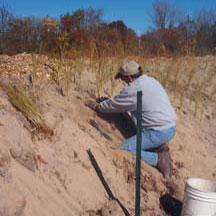What is Restoration?
Ecological restoration improves the functional benefits of natural resources. In other words, restoration ecologists take disturbed and degraded habitats and “restore” the benefits they used to provide or that the ecologists would like them to provide. “Bioengineering” techniques are often used to improve natural resources. These techniques make use of biodegradable soil stabilization materials to temporarily protect plantings from erosive waves, currents and storm water. Ecologists might also re-grade the soil, alter site hydrology, eradicate invasive species, and/or plant native vegetation to restore habitats.
Restoration plant selection
The cultural requirements of plants, rate and volume of flow for streamside plantings, depth and duration of standing water for pond edge and wetland plantings, maintenance requirements, site preparation, purchasing healthy plants, selecting native species, and planting for function all play a role in choosing the right plants for aquatic restoration projects. The species and types of plants used depends on site-specific conditions. What plants have been installed at our aquatic restoration projects? Here is a list of some of the plant species that were installed at our project sites and others that can be used at your site.
| Rich Manor Park |
 Before BeforeAn eroding stream bank and unsuccessful attempt at keeping Canada geese off the adjoining lawn characterized Rich Manor Park in Rye Brook in 1998. |
 After AfterThe stream bank was stabilized using biodegradable mesh blankets and log-shaped structures anchored to the toe of the bank. Native vegetation providing a buffer between lawn and water also acted as a natural and attractive barrier to geese. |
| Echo Bay |
 Before BeforeEcho Bay in New Rochelle was the victim of pollution and neglect. Salt marshes and the fish and wildlife that use them had all but disappeared from the bay by the late 1980s. |
 After AfterLess than a year after it was created at Five Islands Park, this salt marsh is now one of several helping to keep the bay clean and provide shelter, feeding grounds and a nursery to a variety of birds, fish and shellfish. |
| Coastal Dunes |
 Before BeforeCoastal dunes are very scarce in Westchester County. They protect the shoreline during storms and give shorebirds a place to nest. At the Edith G. Read Natural Park and Wildlife Sanctuary in Rye, a fore dune and back dune were created and planted with a variety of dune-loving vegetation. |
 After AfterSix months after they were planted, the dunes began to thrive. Beach grass, goldenrod, beach plum, beach pea, shadblow, and bayberry are among the plants now holding the dunes in place. They also provide cover for nesting shorebirds. |
| East Creek |
 Before BeforeEast Creek flows through Flint Park in Larchmont and Mamaroneck Town. Before the creek was restored, its banks were severely eroded and littered with automobile parts, leaking oil containers, shopping carts and other debris. |
 After AfterDuring restoration, a tide gate was installed, debris was removed, the banks re-contoured to make them flatter, and biodegradable mesh blankets and log-shaped structures were installed. Vegetation now provides permanent stabilization and helps to filter out pollutants. |